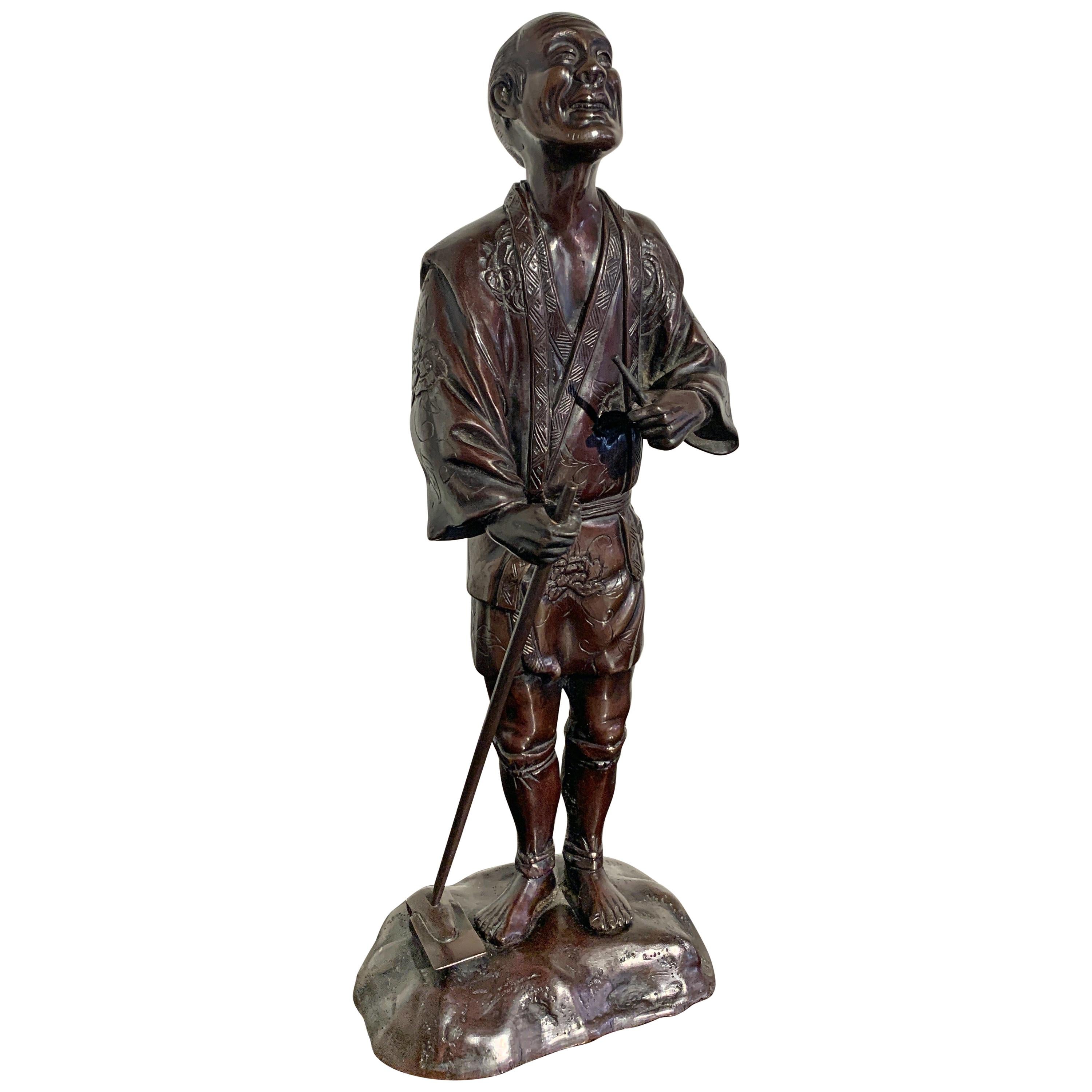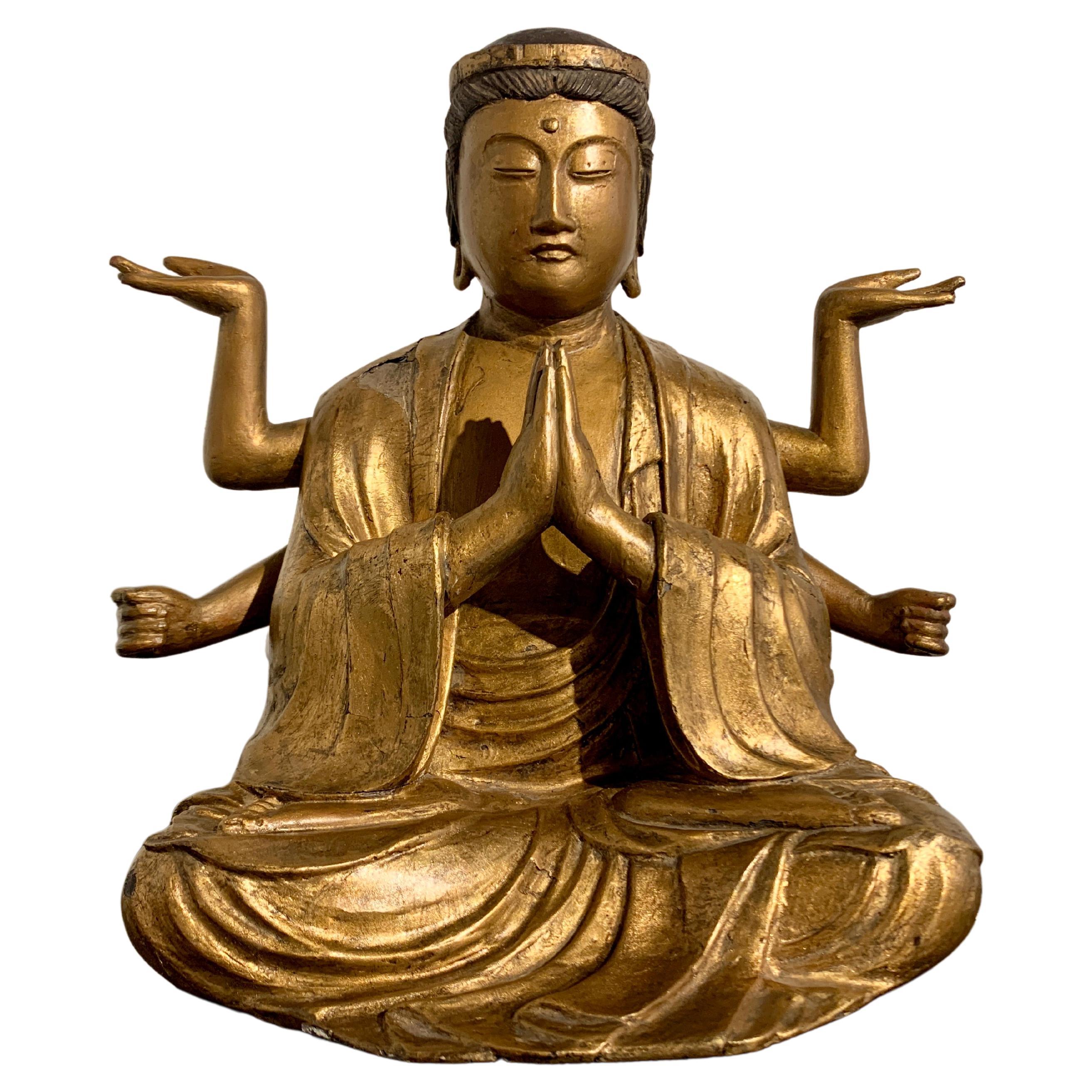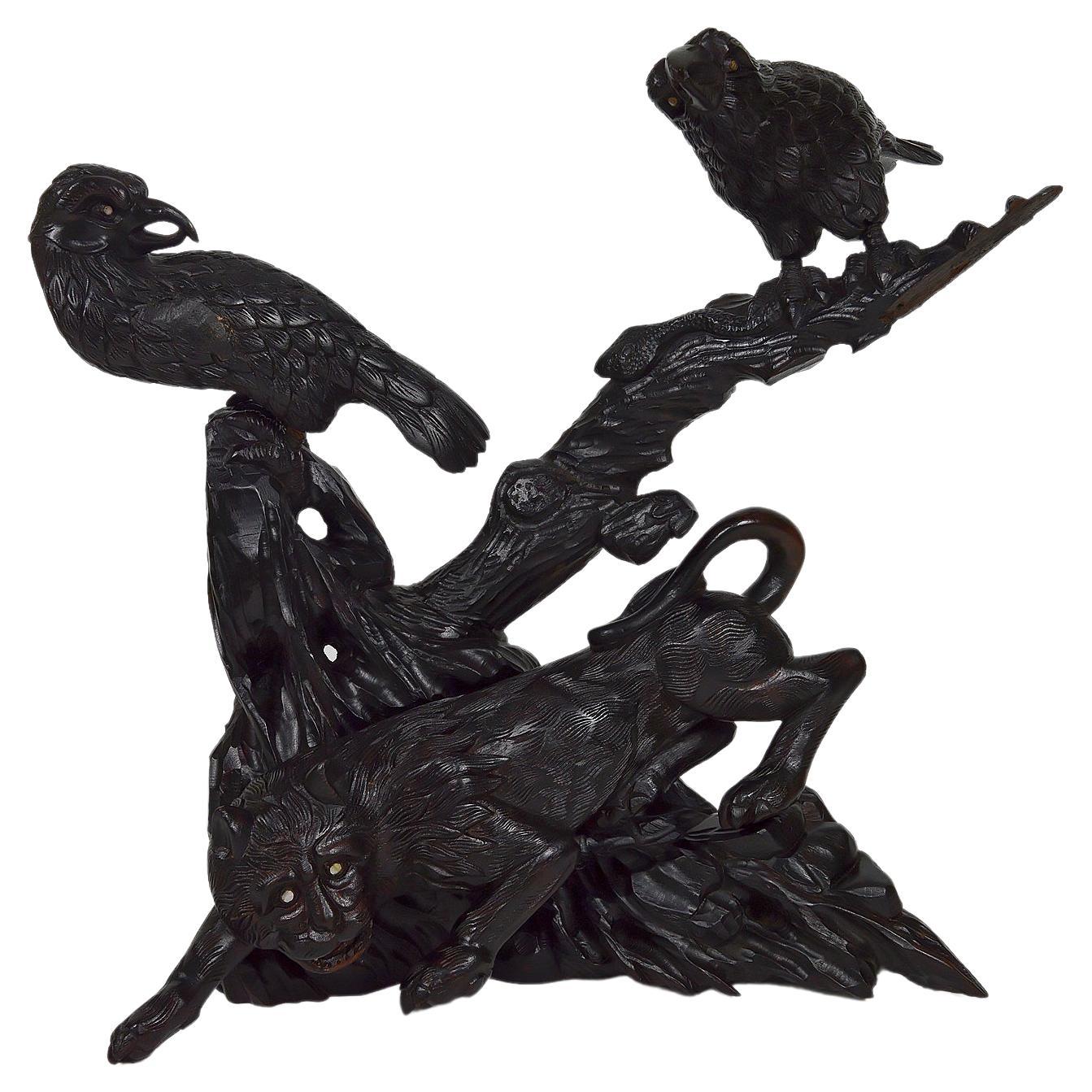Items Similar to Japanese Meiji Period Carved Wood Okimono Man with Rabbits
Want more images or videos?
Request additional images or videos from the seller
1 of 12
Japanese Meiji Period Carved Wood Okimono Man with Rabbits
About the Item
The charming figure, carved from a single piece of wood is exceptionally carved showing the male figure with humorous expression holding two Rabbits one by the ears and the second under his arm. A third Rabbit stands at the feet of the male looking up, each rabbit with a different expression. The male figure is wearing traditional Japanese attire with his hair tied back stood upon a naturalistic base. The figure dates to the Meiji Period (1868-1912) circa 1900.
Notes The Rabbit is one of the 12 animals to feature in the Japanese Zodiac signs which follows the Chinese astrological system along with the Rat, Ox, Tiger, Rabbit, Dragon, Snake, Horse, Goat, Monkey, Rooster, Dog, Pig. Such division is connected with the Jupiter cycle around the Sun, which lasts about 12 years. As 2023 is the year of the Rabbit we are happy to offer this fabulous carving to coincide with this celebratory year of the Rabbit.
In Japanese culture, Rabbits represent fortune, moving forward and cleverness, and are also messengers for the kami or Gods.
Measurements in Centimetres 30cm High x 10cm Wide x 9cm Deep
- Dimensions:Height: 11.8 in (29.98 cm)Width: 3.9 in (9.91 cm)Depth: 3.5 in (8.89 cm)
- Style:Meiji (Of the Period)
- Materials and Techniques:
- Place of Origin:
- Period:1900-1909
- Date of Manufacture:Circa 1900
- Condition:Wear consistent with age and use. Minor losses. Small expansion crack to the base at the rear (see photos).
- Seller Location:Newark, GB
- Reference Number:
About the Seller
5.0
Vetted Seller
These experienced sellers undergo a comprehensive evaluation by our team of in-house experts.
Established in 2019
1stDibs seller since 2022
17 sales on 1stDibs
Typical response time: 3 hours
- ShippingRetrieving quote...Ships From: Newark, United Kingdom
- Return PolicyA return for this item may be initiated within 14 days of delivery.
More From This SellerView All
- Japanese Bronze Torii Gate Sculpture Meiji PeriodLocated in Newark, EnglandBeautifully sculpted Japanese Meiji period Torii gate sculpture. The sculpture made from solid bronze with a beautiful patination throughout dating to the Meiji period 1868-1912 circa 1890. The gate of traditional form representing the Matsuo Shrine in Kyoto. The characters read ???? translated directly to Matsuo Shrine. Notes The Torii gate sculpture was crafted after the famous Torii gate which is found in the Arashiyama district in Kyoto. It houses Matsuno’o Taisha (Matsunoo Taisha ????) one of the oldest shinto shrines in Kyoto dating to 701, approximately 100 years before the city of Kyoto. It boarders the mountains and has a distinct main hall dating to 1397 which is also one of the oldest buildings in the city of Tokyo. The shrine’s spring is famous for its restorative properties and sake and miso producer’s patron the shrine with their particular industries relying on the pure water to survive. The distinct giant Torri gate stands at 14 meters tall alluding to its significance in the city. Three beautiful gardens can...Category
Antique Late 19th Century Japanese Meiji Sculptures and Carvings
MaterialsBronze
- Japanese Bronze Pheasant Okimono Genryusai SeiyaLocated in Newark, EnglandUnusual Casting of a Pheasant in Flight From our Japanese collection, we are delighted to offer this Japanese bronze okimono of a Pheasant upon a naturalistic root wood base. The Ph...Category
Antique Late 19th Century Japanese Meiji Sculptures and Carvings
MaterialsBronze
- Japanese Meiji Period Bronze Group Bear & Alligator by YoshimitsuLocated in Newark, EnglandThe Japanese group comprises of a Bear being attacked by a large alligator. The alligator jumping on the back of the Bear with mouth wide opening showing its razor sharp teeth. The b...Category
Antique Late 19th Century Japanese Meiji Animal Sculptures
MaterialsBronze
- German Memento Mori Carved SkullLocated in Newark, EnglandAntique 18th century fruitwood carved Memento Mori Skull. The skull of petrified display powerfully carved in the form of a human skull consisting of the cranium, upper and lower jaws, the cadaverous face with deliberate missing tooth in brown wash patination throughout. Stood upon a small marble base with the skull attaching via a dowel fitting. The Skull probably from German origin. Notes From approximately the sixteenth century, skulls were commonly used to remember death as they symbolise the transience of human life. Memento Mori literal Latin translation means remember that you [have to] die. The concept has its roots in the philosophers of classical antiquity, and appeared in funeral art and architecture of the medieval period. Memento Mori jewellery...Category
Antique 18th Century German Gothic Mounted Objects
MaterialsMarble
- Japanese Skeleton Boxwood Netsuke Late Edo PeriodLocated in Newark, EnglandJapanese boxwood netsuke depicting a skeleton. The skeleton naturalistically carved in the foetal position in preparation for transitional burial. With...Category
Antique Mid-19th Century Japanese Edo Sculptures and Carvings
MaterialsWood, Boxwood
- Japanese Bronze Vase Pair Meiji PeriodLocated in Newark, EnglandA fine large sized pair of Japanese bronze vases. The vases each surmounted by waisted necks flanked by two spreading handles with accents in the form of Japanese Torri (traditional ...Category
Antique Late 19th Century Japanese Meiji Metalwork
MaterialsMetal, Gold, Silver, Bronze, Copper
You May Also Like
- Japanese Tokyo School Bronze Okimono of a Farmer, Meiji PeriodLocated in Austin, TXA very fine and detailed Tokyo School cast bronze okimono (decorative sculpture) of a smiling farmer, Meiji period, late 19th century, Japan. The e...Category
Antique Late 19th Century Japanese Meiji Sculptures and Carvings
MaterialsBronze
- Japanese Gilt Wood Fukukenjaku Kannon, Meiji Period or Earlier, JapanLocated in Austin, TXAn attractive and esoteric Japanese carved and gilt wood figure of Fukukenjaku Kannon, Amoghapasa, Meiji period or earlier, Japan. Fukukenjaku Kannon is portrayed in an usual six...Category
Antique Early 1900s Japanese Meiji Sculptures and Carvings
MaterialsCypress
- Asian Sculpture / Okimono with Lion and Crows, Japan, Meiji Era, circa 1880Located in VÉZELAY, FRRare and important Japanese sculpture / statue / okimono in blackened and carved wood, depicting 1 lion, 2 birds (crows or other birds of prey) and 1 snake held in the claws of one o...Category
Antique 1880s Japanese Meiji Sculptures and Carvings
MaterialsWood
- Meiji Period Carved Lion and TigerLocated in Pasadena, CAThis is an outstanding pair of Meiji Period carved hardwood figures of a ferocious lion and tiger. The carving is exceptional as is the bone detailing of the mouthes and teeth. The f...Category
Antique Late 19th Century Japanese Meiji Animal Sculptures
MaterialsBone, Hardwood
- Japan 1890 Meiji Period Rare Carved Okimono Of A Father And Son Playing SignedLocated in Miami, FLJapanese Okimono sculpture of a father and son. Very rare and highly detailed sculpture, created during the meiji period (1868-1912) in the imperial Japan, circa 1890. This sculptural Okimono is very well realized and exceptionally proportionate. Show the figures of a father and a son playing, with happiness and smiling. The father hold a big basket at his back and both personages are wearing kimonos richly engraved. This piece was made from a carving with exceptional craftsmanship and intricate details. This sculpture stand itself on his own base and have all retain of the applied ochre ink accents. Measures: 130 mm by 45 mm by 53.3 mm (5.1 x 1.75 x 2.1 inches). Weight: 81.30 grams. Note: This kind of family scene is very rare to seen in nineteenth century japanese iconography. Okimono Is a Japanese term meaning for display an ornament; art object; or decorative object, usually displayed in a tokonoma or butsudan "Buddhist altar". It is an ornament or figure, especially one placed in a guest room. An okimono may be a small Japanese carving, similar to but larger than a netsuke. Unlike the netsuke, which had a specific purpose, the okimono is exclusively decorative and was displayed in the tokonoma. During the Meiji period, many okimonos were made for export to the West. Meiji Period This is an era of Japanese history that extended from October 23, 1868 to July 30, 1912.The Meiji era was the first half of the Empire of Japan, when the Japanese people moved from being an isolated feudal society at risk of colonization by Western powers to the new paradigm of a modern, industrialized nation state and emergent great power, influenced by Western scientific, technological, philosophical, political, legal, and aesthetic ideas. As a result of such wholesale adoption of radically different ideas, the changes to Japan were profound, and affected its social structure, internal politics, economy, military, and foreign relations...Category
Antique 1890s Japanese Meiji Sculptures and Carvings
MaterialsWood, Paint
- Japanese Lacquer, Bone and "Root" Wood Screen Meiji PeriodLocated in West Palm Beach, FLA Japanese lacquer, bone and "Root" wood screen Meiji period, late 19th century of rectangular form, inlaid and applied in relief with finely carved bone with large leafy peony spr...Category
Antique 19th Century Abstract Sculptures
MaterialsLacquer





